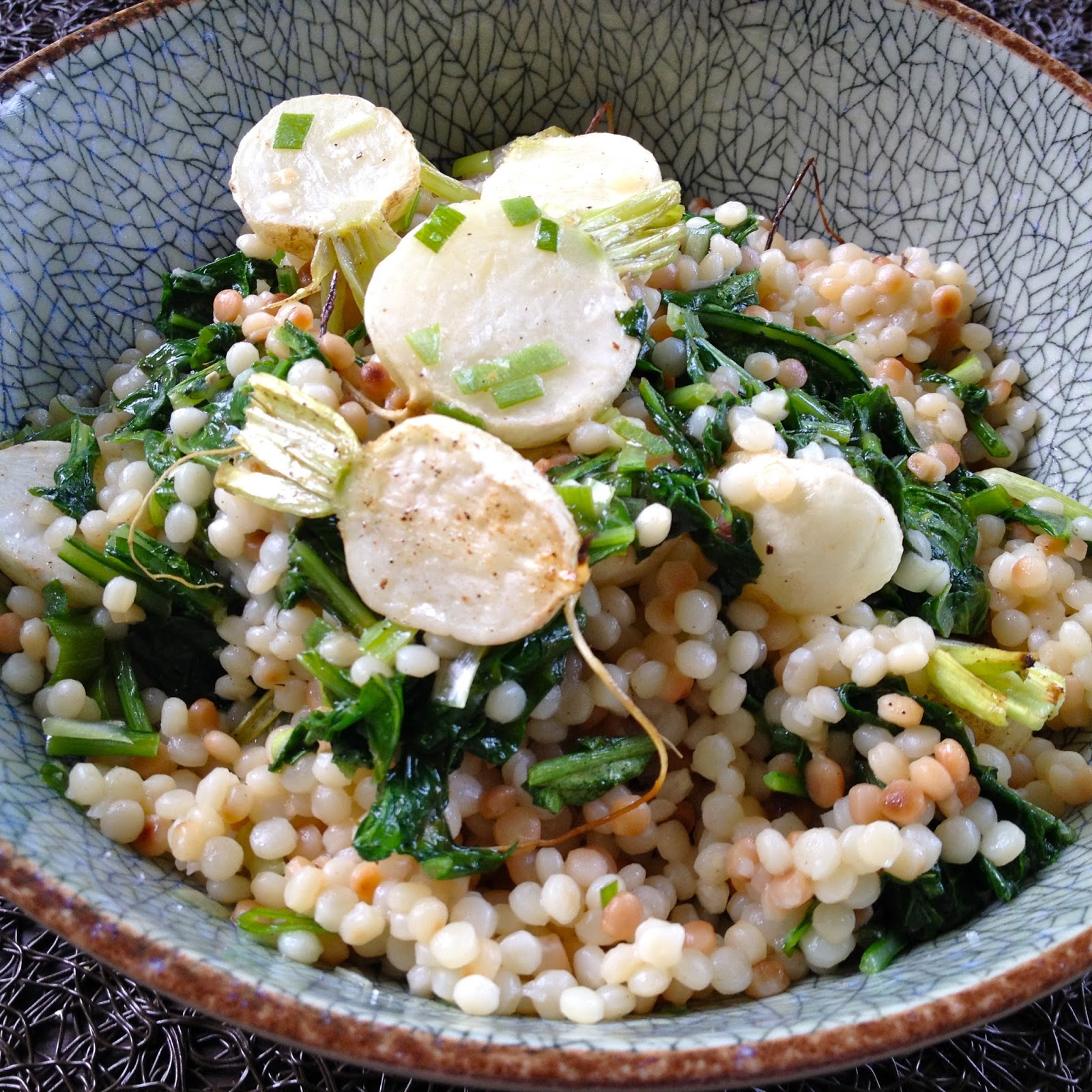Turnips are not sexy
 It is perfectly fitting that I am following a post on prunes -- no matter how much you want to rebrand them "dried plums," prune industry, we all see through your trick -- with another deeply unsexy sounding ingredient: turnips.
It is perfectly fitting that I am following a post on prunes -- no matter how much you want to rebrand them "dried plums," prune industry, we all see through your trick -- with another deeply unsexy sounding ingredient: turnips.I've been getting hakurei turnips at my CSA farm lately. Yes, they are hipster turnips; I make no apologies. They seem to be particularly popular among the organic farm, CSA set, and are a common sight these days at farmers' markets. They're a bit bigger than radishes, with smooth, creamy white, perfectly round roots attached to deep green and unblemished leaves. I pick them up and put them into my bag not because I have any particular idea what to do with them, but just because they're so darn pretty. They taste the way a regular turnip would if it had moved to the city and gone to grad school and ended up making good but not vulgar money and had conversations with friends over drinks at the local in which it had very intelligent but also funny and self-deprecating things to say about the Degenerate Art show or the latest thing at BAM or whatever fantastic television show it's binge-watching. Confident enough of its turnipness to not make a huge point of it, comfortable in its own (very tender) skin.
Now that I've written this down I realize that I would totally date a hakurei turnip.
Haruki Turnip and Pearl Couscous Salad
Serves 4 as a side dish
This recipe is adapted from Not Eating Out in New York, with a few tweaks. It's unusual and delicious, weirdly craveworthy. It uses both the greens and the bulbs of the turnip: the greens are sautéd with olive oil and garlic, the roots are roasted, and they are all tossed with toasted Israeli couscous, lemon, and olive oil. Couldn't be easier, really, despite using three pots, especially if you serve it alongside a simple piece of grilled fish or pork or lamb. I like it room temperature, but you could also have it warm. The key to this or any other pasta salad is that each component of the dish must be seasoned properly before everything is mixed together. If you can't get your hands on these special turnips, I have no doubt this would taste terrific made with in-season radishes, too.
1 bunch haruki turnips
1 c pearl couscous
4 TB olive oil, divided
salt and freshly ground pepper
1/2 tsp cumin
1 clove garlic, minced
3 scallions, white and green parts minced
juice of 1/2 lemon
1. Preheat the oven to 450º F. Cut the greens from the turnip roots, leaving about 1/2" of stem and the little root tail still attached to the roots. Rinse the turnip roots well and slice in half. Slice the greens into 1" ribbons and place in a bowl with cool water to get any grit off.
2. In a small saucepan, heat 1 TB olive oil over medium high heat. Add the couscous, and stir occasionally until the couscous is toasted and some pearls are starting to get brown. Add 1-1/4 c hot water along with 1/2 tsp kosher salt and bring to a boil. Stir the pot once, turn the heat down to low, and cover. Cook for 5 minutes, covered, and then turn off the heat and allow the couscous to remain in the pot with the lid on until you are ready for it.
3. Toss the turnips in a bowl with 2 tsp olive oil, a hefty pinch of salt, a few grindings of pepper, and the cumin. Combine, and then place on a foil-lined baking tray. Roast in the oven for about 10 minutes, until the turnips are starting to brown in spots and are tender. (You may need to add about 5 minutes of roasting time to this depending on your turnips.) When done, remove tray from oven and set aside.
4. Pull turnip leaves out of the water and drain in a colander. (Pull the leaves out rather than drain the bowl into the colander -- if you do the later with any type of green, the grit and dirt that's settled to the bottom of the bowl will get poured back onto your greens!) In a medium sauté pan, heat 1 TB olive oil and minced garlic over medium high heat. When garlic is fragrant, add turnip leaves and sauté for a minute or two until wilted and bright green. Add salt to taste (and actually taste).
5. Throw the couscous, turnips, greens, scallions, lemon juice, and the remaining 1 TB plus 1 tsp olive oil into a bowl, and toss till combined. Taste for seasoning, adjusting the salt and the lemon to taste. Serve at room temperature.
Comments
Okay, now I'm starting to worry about you! :-)
The Israeli cous cous looks great, though. Not seen that here.
Google says that Tesco carries it, Andy. You could always substitute orzo or some other tiny pasta (which is essentially what Israeli cous cous is.
injection moulding company malaysia
packaging biskut raya malaysia
plastic cup manufacturer in malaysia